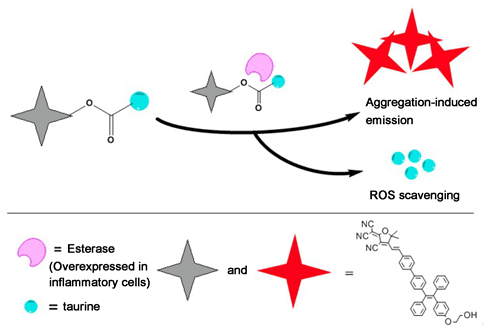| [1] Li, P.; Xiao, H.; Tang, B. Chin. J. Chem. 2012, 30, 1992.
[2] Xia, Z.; Shao, A.; Li, Q.; Zhu, S.; Zhu, W. Acta Chim. Sinica 2016, 74, 351. (夏志清, 邵安东, 李强, 朱世琴, 朱为宏, 化学学报, 2016, 74, 351.)
[3] Fan, J. L.; Xu, Q. L.; Zhu, H.; Peng, X. J. Chin. J. Org. Chem. 2014, 34(8), 1623. (樊江莉, 徐群利, 朱浩, 彭孝军, 有机化学, 2014, 34(8), 1623.)
[4] Chen, Y.; Qiu, T.; Zhao, W.; Fan, L. Polym. Chem. 2015, 6, 1576.
[5] Guo, S.; Zheng, F.; Zeng, F.; Wu, S. Z. Chinese J. Polym. Sci. 2016, 34, 830.
[6] Yu, C.; Li, X.; Zeng, F.; Zheng, F.; Wu, S. Z. Chem. Commun. 2013, 49, 403.
[7] Yu, C.; Wu, Y.; Zeng, F.; Li, X.; Shi, J.; Wu, S. Z. Biomacromolecules 2013, 14, 4507.
[8] Pan, L.; Luo, W.; Chen, M.; Liu, J.; Xu, L.; Hu, R.; Zhao, Z.; Qin, A.; Tang, B. Z. Chin. J. Org. Chem. 2016, 36(6), 1316. (潘凌翔, 罗文文, 陈明, 刘峻恺, 徐露, 胡蓉蓉, 赵祖金, 秦安军, 唐本忠, 有机化学, 2016, 36(6), 1316.)
[9] Chan, J.; Dodani, S. C.; Chang, C. J. Nat. Chem. 2012, 4, 973.
[10] Du, F. K.; Xu, J. S.; Zeng, F.; Wu, S. Z. Acta Chim. Sinica 2016, 74, 241. (杜方凯, 徐江生, 曾钫, 吴水珠, 化学学报, 2016, 74, 241.)
[11] Akdeniz, A.; Mosca, L.; Minami, T.; Anzenbacher Jr., P. Chem. Commun. 2015, 51, 5770.
[12] Sun, J. B.; Zhang, G. H.; Jia, X. Y.; Xue, P. C.; Jia, J. H.; Lu, R. Acta Chim. Sinica 2016, 74(2), 165. (孙静波, 张恭贺, 贾小宇, 薛鹏冲, 贾俊辉, 卢然, 化学学报, 2016, 74(2), 165.)
[13] Shi, D. T.; Zhou, D.; Zang, Y.; Li, J.; Chen, G. R.; James, T. D.; He, X. P.; Tian, H. Chem. Commun. 2015, 51, 3653.
[14] Wu, B. Y.; Yan, X. P. Chem. Commun. 2015, 51, 3903.
[15] Zhang, Z.; Huang, J.; Dong, B.; Yuan, Q.; He, Y.; Wolfbeis, O. S. Nanoscale 2015, 7, 4149.
[16] Hou, X.; Yu, Q.; Zeng, F.; Ye, J.; Wu, S. J. Mater. Chem. B 2015, 3, 1042.
[17] Ding, J.; Li, H.; Wang, C.; Yang, J.; Xie, Y.; Peng, Q.; Li, Q.; Li, Z. ACS Appl. Mater. Interfaces 2015, 7, 11369.
[18] Xu, S. Y.; Sun, X.; Ge, H.; Arrowsmith, R. L.; Fossey, J. S.; Pascu, S. I.; Jiang, Y. B.; James, T. D. Org. Biomol. Chem. 2015, 13, 4143.
[19] Au-Yeung, H. Y.; Chan, J.; Chantarojsiri, T.; Chang, C. J. J. Am. Chem. Soc. 2013, 135, 15165.
[20] He, X. P.; Tian, H. Small 2016, 12, 144.
[21] Hettiarachchi, S. U.; Prasai, B.; McCarley, R. L. J. Am. Chem. Soc. 2014, 136, 7575.
[22] Mei, J.; Leung, N. L.; Kwok, R. T.; Lam, J. W.; Tang, B. Z. Chem. Rev. 2015, 115, 11718.
[23] Gao, M.; Hu, Q.; Feng, G.; Tang, B. Z.; Liu, B. J. Mater. Chem. B 2014, 2, 3438.
[24] Tang, X.; Bai, Q.; Peng, Q.; Gao, Y.; Li, J.; Liu, Y.; Yao, L.; Lu, P.; Yang, B.; Ma, Y. Chem. Mater. 2015, 27, 7050.
[25] Liu, Z.; Xue, W.; Cai, Z.; Zhang, G.; Zhang, D. J. Mater. Chem. 2011, 21, 14487.
[26] Zhang, Y.; Kong, L.; Shi, J.; Tong, B.; Zhi, J.; Feng, X.; Dong, Y. Chin. J. Chem. 2015, 33, 701.
[27] Hu, F.; Zhang, G.; Zhan, C.; Zhang, W.; Yan, Y.; Zhao, Y.; Fu, H.; Zhang, D. Small 2015, 11, 1335.
[28] Yang, J.; Huang, J.; Sun, N.; Peng, Q.; Li, Q.; Ma, D.; Li, Z. Chemistry 2015, 21, 6862.
[29] Gao, Y.; Qu, Y.; Jiang, T.; Zhang, H.; He, N.; Li, B.; Wu, J.; Hua, J. J. Mater. Chem. C 2014, 2, 6353.
[30] Ma, S.; Zhang, J.; Chen, J.; Wang, L.; Xu, B.; Tian, W. Chin. J. Chem. 2013, 31, 1418.
[31] Ewa, K.; Magdalena, P.; Barbara, L.; Malgorzata, O.; Pawel, M.; Wlodzimierz, M. Ann. Rheum. Dis. 2012, 71, 262.
[32] Wu, Y.; Huang, S.; Zeng, F.; Wang, J.; Yu, C.; Huang, J.; Xie, H.; Wu, S. Chem. Commun. 2015, 51, 12791.
[33] Marcinkiewicz, J.; Kontny, E. Amino Acids 2014, 46, 7.
[34] Hou, J. T.; Li, K.; Yang, J.; Yu, K. K.; Liao, Y. X.; Ran, Y. Z.; Liu, Y. H.; Zhou, X. D.; Yu, X. Q. Chem. Commun. 2015, 51, 6781.
[35] Long, L.; Wu, Y.; Wang, L.; Gong, A.; Hu, F.; Zhang, C. Chem. Commun. 2015, 51, 10435.
[36] Reja, S. I.; Bhalla, V.; Sharma, A.; Kaur, G.; Kumar, M. Chem. Commun. 2014, 50, 11911.
[37] Wu, Y.; Wang, J.; Zeng, F.; Huang, S.; Huang, J.; Xie, H.; Yu, C.; Wu, S. Z. ACS Appl. Mater. Interfaces 2016, 8, 1511.
[38] Xiao, H.; Xin, K.; Dou, H.; Yin, G.; Quan, Y.; Wang, R. Chem. Commun. 2015, 51, 1442.
[39] Zhu, H.; Fan, J.; Wang, J.; Mu, H.; Peng, X. J. Am. Chem. Soc. 2014, 136, 12820.
[40] Sun, J. J.; Piao, S.; Cha, Y. N.; Kim, C. J. Clin. Biochem. Nutr. 2009, 45, 37.
[41] Zhou, J.; Du, X.; Li, J.; Yamagata, N.; Xu, B. J. Am. Chem. Soc. 2015, 137, 10040.
[42] Wang, J.; Wu, Y.; Zeng, F.; Huang, S.; Wu, S. Faraday Discuss. 2016, DOI:10. 1039/C6FD00118A.
[43] Pan, G.; Liu, S.; Zhao, X.; Zhao, J.; Fan, C.; Cui, W. Biomaterials 2015, 53, 202.
[44] Yang, Y.-C.; Lu, H.-H.; Wang, W.-T.; Liau, I. Anal. Chem. 2011, 83, 8267.
[45] Salonen, T.; Sareila, O. U.; Kankaanranta, H.; Tuominen, R.; Moilanen, E. Br. J. Pharmacol. 2006, 147, 790.
[46] Wang, B.; Yu, P. F.; Song, P.; Sun, X.; Yang, S.; Lou, Z.; Han, K. Chem. Commun. 2013, 49, 1014.
[47] Karlsson, M.; Kurz, T.; Brunk, U. T.; Nilsson, S. E.; Frennesson, C. I. Biochem. J. 2010, 428, 183. |
